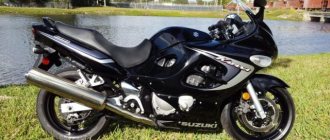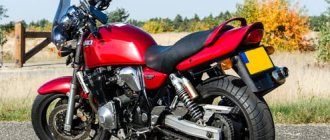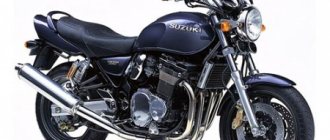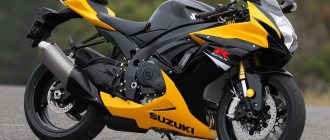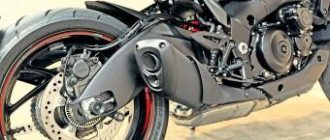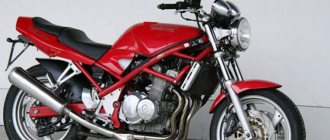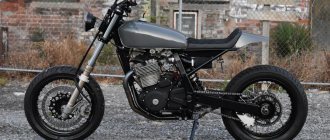Unlike the Bandit 400, which belongs to the naked class, the Suzuki Impulse GSX 400 is a road bike. Its production began in 1994 . The production continued until 2000 .
In 2005, production plans were revised, the model was radically redesigned, after which production began again. The second, final stop occurs two years later and in 2008 the bike goes down in history .
Brief history of the model
1984 – start of production of the model. During this period the motorcycle had 59 hp. power and 38 Nm of torque, with a dry weight of 152 kg.
1985-1987 - the motorcycle receives more advanced engine and carburetor settings, resulting in improved traction at medium and high speeds. The model also receives electrical upgrades and a shorter wheelbase. During this period, the motorcycle uses innovative SATCS technology - the engine is cooled by liquid, oil and air.
1988 - Suzuki GSX-R 400 gets a new frame and appearance. Due to the use of a reinforced chassis and a different exhaust pipe design, the weight of the motorcycle increases slightly. This period is also marked by the use of new carburetors, chrome exhaust and 4-piston Tokico calipers.
1990 - the model receives a new reinforced frame, an inverted fork, new plastic, front 4-piston Nissin calipers, a new swingarm and exhaust system. Thanks to the new exhaust, 60 hp were removed from the engine. at 14500 rpm.
1993 - Under new Japanese legislation, all 400 cc motorcycles must have a power limit of 53 hp, which is why the Suzuki GSX-R 400 was “strangled” (like other models in its class) to meet the new safety standards.
1999 - Suzuki GSX-R 400 officially discontinued.
Modifications
Suzuki IMPULSE GSX 400 S is the same motorcycle, only with a fairing.
The bike has only one official modification - Suzuki GSX 400 S. The filling of the model is the same. The only difference is the presence of a front half-fairing. This model is sometimes labeled as Type S.
But there is another motorcycle in the 400 line with the same abbreviation. Suzuki GSX 400 Inazuma . Also the model is only for Japanese use and was also available in other countries' markets.
and competitors
Honda CB 400.
Kawasaki ZZR 400.
Yamaha XJR 400.
The situation with competitors is quite interesting. Among them there are models from all Japanese manufacturers, and bike components are also suitable from any of the listed ones.
- For Honda, this is the legendary CB 400 .
- For Kawasaki - the no less legendary zizer, ZZR 400 .
- And Yamaha introduced the XJR 400 .
Specifications
| Model: | Suzuki GSX-R 400 |
| Type: | Sports |
| Year of issue: | 1984 - 1999 |
| Frame: | Aluminum |
| Engine's type: | 4 - cylinder, 4 - stroke |
| Working volume: | 398 cc cm. |
| Bore and stroke: | 56 mm x 40.4 mm |
| Compression ratio: | 12.0:1 |
| Cooling: | Liquid |
| Number of valves per cylinder: | 4,DOHC |
| Fuel supply system: | 4 carburetors |
| Ignition type: | Electronic |
| Maximum power: | 53 hp at 12000 rpm. |
| Maximum torque: | 37 Nm at 9500 rpm. |
| Transmission: | 6-speed |
| Type of drive: | Chain |
| Front tire size: | 120/60-17 |
| Rear tire size: | 160/60-17 |
| Front brake: | two 310 mm discs, 4 piston calipers |
| Rear brake: | one disc 220 mm, 1 - piston caliper |
| Front suspension: | Inverted telescopic fork (all adjustments) |
| Rear suspension: | Monoshock with progression |
| Wheelbase: | 1435 mm |
| Acceleration to 100 km/h: | ~ 5 sec. |
| Maximum speed | 180 km/h |
| Gas tank capacity: | 16 l. |
| Dry weight: | 169 kg. |
Driving performance
The maximum speed declared by the manufacturers is 180 km/h . According to the owners, the mark is reached in one go, although the motorcycle gains more than 140 very reluctantly. Comfortable cruiser - 80–100 km/h .
Acceleration to hundreds (dynamics)
According to users, the mot is generally not bad. It steers easily and clears traffic jams quickly. But if you want drive, you need to keep the speed above 7000 rpm, which will inevitably affect fuel consumption.
Acceleration dynamics are within the class. From 0 to 100 km/h in 5 seconds. It is curious that those who checked the dynamics with the second number spoke for 6 seconds.
Fuel consumption
Since the bike (like all 400) was planned primarily for sale only in Japan, the consumption in the documents is indicated in its own way - 2.75 liters per 100 km , at a constant speed of 60 km/h with the second number on board.
According to Russian owners - 5-5.5 liters , depending on driving style and road quality. In the city it can be 6-7 liters , on the highway - about 4 liters .
Experience using the Suzuki GSX 400 Impulse motorcycle
I skated the season on this unit. As always, before purchasing there was a difficult choice of what to take, what to ride... I was looking at motorcycles with an engine capacity of at least 400. I read reviews, impressions, and looked at options. The 600s gradually fell away due to the price tags, so I concentrated on scabies. Of course, the Honda cb400 gets the most praise, and there is quite a wide selection of them. But I was scared off by the stale years and outrageous price tags. For a fairly recent Honda CB400 from 2003-2006, they asked for almost the same amount of money as for their older brother, the Honda CB600 Hornet . Well, for reasonable money (100-130 thousand rubles) they sold older than 98 years, with a mileage of 20-40 thousand km, which is also not very believable.
The Suzuki GSX 400 Impulse accidentally caught my eye . I was interested in the unit. It looks basically the same Honda CB400 . Those. The characteristics of all scabies are generally similar, so I tried to find information, reviews from owners, in short, at least something... This is quite difficult. There are not so many of them in Russia, a Japanese spendthrift, for the domestic market (just like everyone else))), but we managed to collect some information.
I came across a 2003 version for 110t.r. The price tag is quite humane, after inspection the condition turned out to be quite tolerable. Next is the actual purchase, registration...
Overall the mot is not bad. It steers like a bicycle and clears traffic jams with a bang. Dynamics in the region of 5 seconds to 100 km.h. When driving with number 2 it drops to about 6 seconds. Like all scabies up to 6t. rpm it drives quite calmly, after which the engine wakes up and spins up to 12-13 rpm (before the cutoff). If you want to play around, then you need to keep the engine at about 7-8 rpm. This will provide sharp throttle response and excellent dynamics. The tank is 16-17 liters with a reserve, without - about 13. Consumption is 5-6 liters, again depending on how you unscrew it. Acceleration is vigorous, but after 140 it fades, I accelerated to a maximum of 170, there was still some reserve, but it was not comfortable, without a windshield. The box is clear, 6 steps. Another plus is the relatively large trunk under the seat.
In terms of maintenance and consumables, everything is also quite simple. Some parts come from bandit, some from cb. There is no need to order consumables, everything is available in motorcycle stores (changed oil filters, air filters, chain, spark plugs, cleaned and synchronized carbs,...), look at the motor's VIN code.
During the season I drove about 9t.km. There were no problems or breakdowns. I was pleased with the motor, a good option for a beginner.
Cheerful, sharp, perfectly controlled.
My first Japanese motorcycle was a 1994 SUZUKI GSX-400 Impulse. Its main competitors: HONDA CB-400 SF , YAMAHA XJR-400 , KAWASAKI ZRX-400 . I bought a motorcycle completely for free, 3 pieces fell from the sky without any effort. I've been wanting something Japanese for a long time. Oddly enough for a beginner, I wanted a classic (because it’s so fashionable right now - you need sports, the antler darned and the chicks fell over from the sight, and the fact that I don’t know how to drive and have no protection is not for real-life boys), since I did not suffer from a painful awareness of my “uncoolness”. The money for this dream was a little more than 3,000 Baku (it was spring 2003, April).
To be honest, I wanted either a Kawasaki Zephyr-750 or a Honda SV-750 , since I had quite a lot of experience in driving Urals and Izhas. But it was unbearable, and there was no time within 3000 to properly study the market for them. Therefore, I ran into the **** salon and, having slightly aimed at 750, I realized that there was enough money for a “mot”, but for equipment it was a fig, I decided to look at 400. Moreover, the manager, having learned that this would be my first Japanese, definitely recommended 400 Like, you will always have time to kill. Well, I bought this device for 2800 and was happy! I delivered the motorcycle to a friend’s garage on a rainy, cold day. I didn’t have a license or other documents. I repeat again that I am not one of the REAL-patsanoffs and was in no hurry to get on the road without a license. In general, soon all the docks were in order and I started riding the Impulse with a short “long distance” of 400 km. Immediately I felt the assertiveness of the engine (with the discount that this is a 400-hectare, they all have 400-hectare ones) and the no less assertiveness of the oncoming air flow. Without hesitation, at the right moment on the highway I set the speedometer to 180 and realized that my next purchase would be a windshield. The bike pleased me with its convenience, noiselessness and proper operation. Yes, and it was also very beautifully colored, yellow and white, I really liked it. In its class, the motik was the lightest and was declared as the fastest and most dynamic of the classic 400 classics (please do not confuse it with the neoclassics). Of course, it seemed to me the height of perfection, it was pleasant to climb through traffic jams, climb through the forest (clearance allowed, since instead of the original shock absorbers that leaked (after flying into a good hole), they were from some kind of chopper, presumably from a Yamaha Virago 400 (XV 400) , water cooling did not allow the motorcycle to overheat. The suspension was, of course, like all 400 classics, a little soft, but still in moderation. And considering my not small weight, it is quite suitable for our roads. In general, this bike is Suzuki itself was considered at that time one of the most successful. Everything in it was done competently and of high quality. But the creators missed the mark with the choice of "carbs". "Mikuni" suffers from many ailments from time to time, "Keihin" is preferable in this sense. And in In general, the bike is very good and reliable, I drove about 25,000 km on it in a season and a half. For 400 in such a short period of time and on our roads, the figure is very good. And now the Impulse has been sold to a friend and for these 25 thousand significant changes in " motika" did not happen. All you need is competent, careful tuning of the carbs, which is not yet done everywhere and is not cheap. Overall, I’m very pleased with the Motik, I highly recommend it to beginners, don’t let the relative rarity of this model scare you, all consumables are sold without problems in Moscow, but I ordered the air filter in Japan. It was winter and there was nowhere to rush, although if you looked, you could find it in stores, I think.
In general, the main criterion when choosing a motorcycle 400 is whether you like/dislike the appearance, how comfortable/uncomfortable it is to sit, and how “wobbly” a particular instance is. And numerous questions in the forums “which is more reliable, what are the problems with this model” - it’s all nonsense. With such questions you need to approach the “soviet bikes”; this does not apply to the Japanese 400, since all “motos” are tailored according to the same principle and have almost identical characteristics. And 400-acre engines are almost the pinnacle of engine-building perfection, so don’t bother yourself and others with empty markets, grab a competent mechanic and go through showrooms and advertisements, choose the one that’s comfortable to sit on and that pleases the eye.
What can you say about the Suzuki Impulse 400 ?
In general, I took this model for myself as the first of 400 ok, I previously raced a Honda CBR250R . To begin with, it seemed nimble and fast to me. After a month of driving...problems began with the mikuni carbs...the model was produced in 1994...however, it came from Japan in 2006 and no one climbed there, and there was no need, in general I cleaned it, changed the spark plugs, made a faucet fuel supply, installed a filter and it still filled the spark plugs, stalled, and did not work smoothly.
After meeting with Glushak, everything was decided; as it turned out, this man is excellent at dealing with these problems and solves them quickly! The next day I was just flying on impulse…….right now it’s in Lipetsk.
Go to the Suzuki GSX 400 Impulse
Reviews
Reviews about Suzuki GSX-R 400:
Expand Collapse
I've been driving it for the 3rd season now, only changing consumables. I changed the battery almost immediately after purchase, but it turned out to be dead from the previous owner. I cleaned the carbs at the end of the 2nd season. At first it was scary to go there because I didn’t know, but then, with the help of a friend, I figured it out. It turned out to be as simple as shelling pears!
In general, the mot is excellent! If you have a head on your shoulders, you can sit down and ride! He gives you the pleasure of having your pants full! + Since childhood, I adored the sound of passing motos, and this one has an excellent exhaust, it brings me to complete ecstasy.
In short, I think that it’s not worth looking at 250s at all! This is a waste of money and time, anyway, after riding for 2-3 weeks you will want more! But on the 400k, after all, you won’t be able to get off without experience for 2-3 years! Especially with such a daring one as the jixer)))) and the landing is excellent and the explosions of the jixer are funny when necessary! In general, I’m glad that I started my motorcycle journey with this model!
The motorcycle was bought from a friend, but in the end I regretted buying this motorcycle. Even though the motorcycle was born in 1995, there were minor breakdowns. The motorcycle was problematic, namely: a rusty tank, dead carbs, oil waste, running out of liners, oil seals. I didn’t drive it for long because it was being repaired for most of the time. The conclusion suggests itself: if you buy an old motorcycle, pay a lot more attention to it because then problems will arise that will have to be solved and this will hit your pocket. For example, carburetor synchronization 5 t.r 2 times a year must be done. If the motorcycle is in good condition, then enjoy it =)
This post contains some small observations on the fact of owning such an unpopular bike in Russia as the Suzuki GSX400FSV “Inazuma” . All photos are of my now former motorcycle! I offer not only technical specifications and dry figures, but also my personal observations, as well as impressions of owning it! Attention: the text contains a sufficient number of photos that are literally “eating” your expensive traffic)))
Fate brought me together with this motorcycle at the beginning of my motorcycle life, so previously I had essentially nothing to compare it with. Skipping the snot about how I came to such a life and bought myself a motorcycle, I’ll summarize: in the fall of 2013, and specifically in October, I purchased a juicy blue motorcycle of Japanese origin, which was imported into the harsh Russian reality in 2011 (if My memory serves me well).
It came to me already with some goodies, namely: + a case with fastening (I traveled only with it, a jacket, gloves and a helmet for the second number fit in); + side bars protecting the CrazyIron engine (they already had abrasions); + shortened clutch and brake levers, beautiful metal handles and mirrors in which everything is very clearly visible, not like the stock round ones! (by the way, just so there is no doubt, the stock mirrors were given to me in addition). + BOSPerformance can – the sound is simply wonderful: not a stock muffler and not a direct flow! + a windshield on the headlight (allows you to move up to 120 without straining at all on the highway), if you remove it, you will have a beautiful “chrome” tidy a la classic.
Having somehow overwintered and prepared the moto for the new season, I began to ride and get used to it.
As a result, we have: an excellent motorcycle for Russia! An ideal option for beginners, and especially for tall ones! No worse than a seabird (Honda CB400), that's for sure! The frame of Inazuma 400 is similar to the one installed on 1200, and from the outside everything also looks like an adult (some people even make mistakes and at first glance do not believe that it is scabies). I drove my 184 to 105 cheerfully and properly, while on the Sibikh I again seemed awkward, like on a donkey. The motorcycle is reliable and unpretentious; no chronic diseases were identified during operation. It doesn’t consume oil, the Michelin tires provided good grip, even in the rain (I used to corner in a corner before touching the pegs and didn’t feel any discomfort)! The oil was poured 4T Motul 7100 10w40. I also lubricated the chain with Motul.
By the way, the suspension is the famous Kayaba (KYB), the brakes are no less famous BREMBO! There’s a small problem with the suspension, namely, it’s not enough for a full-fledged Russian person with a broad and heavy soul))) No, I rode alone for my own pleasure and didn’t blow my mind, but with the second number I felt all the delights of our Russian roads and directions! At the same time, if even a steep turunda can break through in the pits, then swaying on road waves and periodic breakdown during resonance really forced me to strain! In total we have: my centner of weight and the second number are about 50 kg. In general, if both the pilot and the passenger weigh 60-70 kg, then there shouldn’t be any special problems; if it’s more, then it makes sense to either do some magic with the suspension, or ride alone, or lose weight, or take another bike! The saddle on this motorcycle is solid and quite wide. I, with my broad “soul,” felt quite comfortable on it! 200 km. from refueling to refueling, they were carried without much strain. I haven’t traveled long distances, so what happens there after 500 km. and more - I just don’t know... The second number also never complained about the inconvenience of landing. There is nothing special to say about the brakes! For the 400 it’s the best, at the same time I blocked the rear wheel more than once (there were situations), but I jammed the front one carefully and thank God I never felt the consequences of blocking the front wheel! Although the deceleration is quite significant when braking. In general, there are no complaints about the brakes. I did not conduct special testing of certain components and assemblies. I won’t compare it with anything in particular, so as not to be unbiased. If anyone has experience comparing or owning a similar bike, please share it in the comments.
The instrument panel is moderately informative. It is analog, naturally, and reflects only the most necessary things! There is no gear indicator. There is a bit of glare in the sun and it is not always possible to see the indicators (lamps) right away, but you can see the arrows without problems in any sun. The remote controls are standard, there is an emergency gang.
I also can’t identify any particular complaints about the engine. Quite a reliable motorcycle. Carb naturally. Last season I cleaned and synchronized the carbs in the workshop, and you know, to be honest, I didn’t feel much of a difference in dynamics... It accelerates quite quickly for a 400 and my weight. I compared them with the same Seabikhs - the VTEK ones are certainly more fiery than Inazuma!.. And so, they ride approximately the same. All manipulations and replacements of consumables are according to the regulations, there is nothing special here, just like on all bikes! I poured 92nd gasoline, tried 95th - no difference (significant and noticeable)! Consumption is something like 4.5-7 liters per hundred (depending on how and where you drive). The tank is spacious - 19 liters, if my memory serves me correctly! Enough for a long time with stable driving! In the spring, after hibernation, the engine starts the second or third time! In the aisle he behaves quite confidently. The steering wheel is not too wide, lower than the mirrors of GAZelles, but approximately on the same level as cars.
In general terms, this is a classic road motorcycle model that appeared in 1997 on the basis of the older model Suzuki Inazuma 1200. The model was domestic to Japan and was not officially supplied to foreign markets. Comparing the Suzuki Inazuma 400 with other similar motorcycles from the company, and in particular with the Suzuki GSF 400 Bandit, most people will not find any significant visual differences between them, however, these are different classes of motorcycles. Suzuki GSF 400 Bandit is a naked bike with a sporty riding position, monoshock absorber and other features typical of naked bikes of that time. The Suzuki Inazuma 400, on the other hand, is a classic with a comfortable upright riding position, a simpler air engine, twin rear shock absorbers and greater dry weight. A special feature of the Suzuki Inazuma 400 is an in-line 16-valve, 4-cylinder, air-oil-cooled engine producing 52 hp. and 36 Nm of torque. The engine is high-speed and produces maximum performance at 9500-11000 rpm.
I heard that some owners of Suzuka (and some other motorcycles) complain about unclear gear shifting and the second one slipping out! So I didn’t see this on my bike! The first speed turns on with a slight crunch (this is normal, because it’s not a Honda after all and this is acceptable), the remaining speeds are quite clear and quiet! The second one flew out a couple of times, and then only when I abruptly started from a traffic light and flew forward! Under no circumstances did this happen again. The motorcycle has standard ground clearance, high speed bumps can be driven over with teal (maybe my weight matters here), I’ve ridden it off-road: if you don’t get into the mud, it handles quite well on forest paths, shallow sand, etc.
So I didn’t see this on my bike! The first speed turns on with a slight crunch (this is normal, because it’s not a Honda after all and this is acceptable), the remaining speeds are quite clear and quiet! The second one flew out a couple of times, and then only when I abruptly started from a traffic light and flew forward! Under no circumstances did this happen again. The motorcycle has standard ground clearance, high speed bumps can be driven over with teal (maybe my weight matters here), I’ve ridden it off-road: if you don’t get into the mud, it handles quite well on forest paths, shallow sand, etc.
Externally, the motorcycle looks very interesting, classic - it undoubtedly attracts attention, but it does not add centimeters to the length (if you know what I mean))) The sensations from riding a bike are only positive (there is still some zest in the fact that when turning The steering wheel rotates and the tidy, and not just the fork, like on plastic rice grinders! If there were better wind protection, maybe I would buy myself a classic bike next...
In general, this is not a bad, and in some cases even excellent, motorcycle! I saw girls riding it without difficulty. The disadvantages also include the absence of any normal manual! Of course, I dug up something similar, but I still have to figure out a lot of things myself! True, this should not be misleading, since the motorcycle is quite simple, technically, and logical! After just over two seasons, I decided to sell it, so in the fall I washed it, cleaned it, prepared it, and put it up for sale after wintering!
Since I wanted to sell the motorcycle and not sell it, in March, a new owner was found for it quite quickly and safely! I hope the motorcycle will only please him and not upset him at all! Although it’s hard to part with such a close, reliable and familiar bike!..
I really hope that this post will help those who are deciding on choosing their bike, because... There are not many reviews on the Internet about this particular motorcycle! Finally, I’ll throw in a few photos of me on this bike:
Finally, I’ll post a short video of a cold start for those choosing a motorcycle:
Good luck to everyone and have a long, long unforgettable season!
PS It turned out to be more of a post-memory than a full review, so I ask you not to throw too much pissing slippers, but to understand and forgive))) Well, I’m a sentimentally harsh biker, at times...
